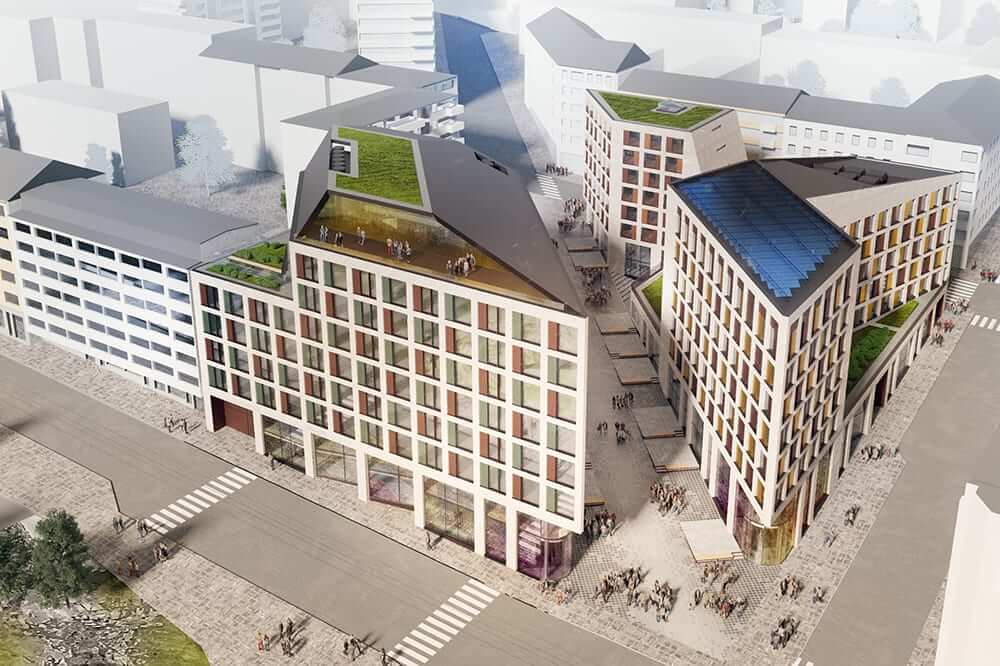Kallio Office Buildings are down – what happens next in the demolition?
1.6.2020
The Lyyra construction site has reached the stage where all above-ground parts of the old buildings have been demolished. In the demolition work of Lyyra, the objective is a utilisation rate of over 95 per cent, which means that most of the dismantled materials will not end up as waste but will be reutilised as construction material.
The Kallio Office Buildings have disappeared from the corner of Toinen Linja and Porthaninkatu as the Lyyra demolition project has progressed over the spring. Yet there is plenty of demolition material still remaining on the plot that is currently being transported off site. From a legislative point of view, once a wall is demolished and the concrete it was built with falls to the ground, waste has been produced. These days, however, demolition waste can also be seen in a different light: it can be used as a source of valuable materials that can be reused.
“A significant part of raw and processed materials is used each year in construction. In order to improve our carbon footprint, a high utilisation rate of materials should be used as the starting point for the demolition of buildings. Sustainable and responsible construction requires us to allocate a substantially larger role to circular economy in our projects than thus far,” comments Ylva’s CEO Antti Kerppola.
At the moment, about a third of the demolition materials from the Lyyra site has been transported off site, with plenty of concrete still remaining on the site. This means that there are important stages left in the demolition work in terms of material efficiency and circular economy in order to utilise the demolition materials as smartly as possible. There is yet more concrete waste to come, not only from the buildings’ foundations but also from the demolition of the two underground basement levels on the side of Kolmas Linja, the floor and foundation walls of the garage on the side of Toinen Linja and some above-ground structures at the metro entrance.
“We anticipate that more than 95 per cent of the materials created during the demolition can be reutilised. Right now, the utilisation rate is 99 per cent. There is a lot of material still to be transported and treated, but the project is fully on schedule. On the Lyyra site, the largest single section of waste from the demolition phase is concrete waste, which accounts for around 90 per cent of the site’s demolition materials,” says Business Unit Director Kimmo Palomäki of Delete Demolition Ltd.
Most of the concrete from the buildings demolished on the Lyyra site will be utilised in civil engineering works at the Hyvinkää shooting range, where the range’s contractors Ventoniemi will be building some protective walls and ground structures for the range out of the demolition materials. Concrete has also been transported to Helsinki Region Environmental Services Authority, HSY’s Eco-industrial Centre Ekomo at Ämmässuo. In Ekomo, Delete have their own concrete treatment station where they process the materials into CE-marked DeleKivi recycled aggregate.
The primary raw material of DeleKivi is the concrete and brick waste created in the demolition of buildings. DeleKivi can be used as a substitute for virgin material that has, for example, been quarried from bedrock and crushed, which makes the product a worthy alternative from the point of view of circular economy in construction.
“It is Lyyra’s objective to be Finland’s most sustainable building once completed – in order to achieve this, each step must be planned to reflect the principles of sustainable development. Whether we are talking about the reutilisation of demolition materials or a more inclusive construction site,” sums up Construction Manager Olli Olkkonen.
Further information:
Olli Olkkonen, Construction Manager, +358 40 085 3300
Jannica Aalto, Communications and Marketing Director (media inquiries) +358 45 1347 636
Fact box:
– From a legislative point of view, the materials created during demolition are waste, but if dismantled and treated correctly, harmless waste can be made into new materials that can be reutilised.
– Approximately 1.6 million tonnes of construction and demolition waste is created in Finland each year, of which the majority, around 85 per cent, comes from renovations and the demolition of entire buildings.
– In the Lyyra project, the objective is a utilisation rate of over 95%. In Finland, the average construction waste utilisation rate was 54% in 2017.
– Lyyra is part of the Green Deal agreement between the Ministry of the Environment and the real estate association Rakli, which strives for a utilisation rate of over 70%.
– The demolition work of Lyyra has been contracted to Delete Demolition Ltd, the largest demolition contractors in Finland.



